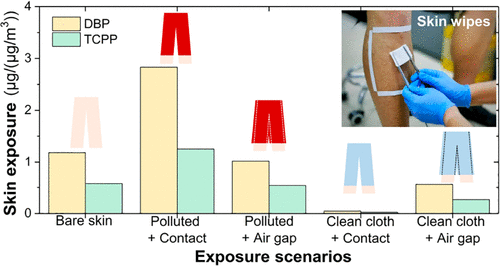当前位置:
X-MOL 学术
›
Environ. Sci. Technol. Lett.
›
论文详情
Our official English website, www.x-mol.net, welcomes your feedback! (Note: you will need to create a separate account there.)
Role of Clothing in Skin Exposure to Di(n-butyl) Phthalate and Tris(1-chloro-2-propyl) Phosphate: Experimental Observations via Skin Wipes
Environmental Science & Technology Letters ( IF 10.9 ) Pub Date : 2021-01-21 , DOI: 10.1021/acs.estlett.0c00993 Ningrui Liu 1, 2 , Jianping Cao 3 , Jing Huang 4 , Yinping Zhang 1, 2
Environmental Science & Technology Letters ( IF 10.9 ) Pub Date : 2021-01-21 , DOI: 10.1021/acs.estlett.0c00993 Ningrui Liu 1, 2 , Jianping Cao 3 , Jing Huang 4 , Yinping Zhang 1, 2
Affiliation

|
Skin exposure is an important pathway for exposure of humans to semivolatile organic compounds (SVOCs). Existing studies have proven that clothing can either impede or aggravate skin exposure to SVOCs. The role of clothing is affected by two factors: clothing conditions (SVOC concentrations in clothing) and skin-to-clothing contact forms (direct and indirect contact). To reveal the co-effects of these two factors, a series of 3 h exposure experiments involving three participants were conducted. Two SVOCs commonly found in indoor environments, di(n-butyl) phthalate (DnBP, plasticizer) and tris(1-chloro-2-propyl) phosphate (TCPP, phosphorus flame retardant), were selected as the target pollutants. The skin-wipe method was used to collect the amount of SVOCs on the skin surface to reflect the levels of skin exposure to SVOCs. The results indicated that the clothing already contaminated by DnBP and TCPP (SVOC-contaminated clothing) significantly aggravated skin exposure while the “clean” clothing (free of DnBP and TCPP) had significant impeding effects. Skin-to-clothing direct contact tends to maintain the effects of clothing condition on skin exposure, while indirect contact tends to weaken the effects of clothing condition. This study should be helpful for understanding the impacts of clothing on skin exposure to SVOCs.
中文翻译:

服装在邻苯二甲酸二正丁酯和磷酸三(1-氯-2-丙基)酯中的作用:通过皮肤擦拭的实验观察
皮肤暴露是人类暴露于半挥发性有机化合物(SVOC)的重要途径。现有研究证明,衣服可能会阻止或加剧皮肤接触SVOC。衣服的作用受两个因素影响:衣服状况(衣服中的SVOC浓度)和皮肤与衣服的接触形式(直接和间接接触)。为了揭示这两个因素的共同作用,进行了一系列的三小时接触实验,涉及三个参与者。在室内环境中常见的两种SVOC,di(n选择邻苯二甲酸丁酯(DnBP,增塑剂)和磷酸三(1-氯-2-丙基)酯(TCPP,磷阻燃剂)作为目标污染物。皮肤擦拭法用于收集皮肤表面的SVOC量,以反映皮肤接触SVOC的水平。结果表明,已经被DnBP和TCPP污染的衣服(被SVOC污染的衣服)显着加剧了皮肤暴露,而“干净”的衣服(不含DnBP和TCPP)具有明显的阻碍作用。皮肤与衣服的直接接触往往会保持衣服状态对皮肤暴露的影响,而间接接触则倾向于减弱衣服状态的影响。这项研究应有助于理解服装对皮肤接触SVOC的影响。
更新日期:2021-03-09
中文翻译:

服装在邻苯二甲酸二正丁酯和磷酸三(1-氯-2-丙基)酯中的作用:通过皮肤擦拭的实验观察
皮肤暴露是人类暴露于半挥发性有机化合物(SVOC)的重要途径。现有研究证明,衣服可能会阻止或加剧皮肤接触SVOC。衣服的作用受两个因素影响:衣服状况(衣服中的SVOC浓度)和皮肤与衣服的接触形式(直接和间接接触)。为了揭示这两个因素的共同作用,进行了一系列的三小时接触实验,涉及三个参与者。在室内环境中常见的两种SVOC,di(n选择邻苯二甲酸丁酯(DnBP,增塑剂)和磷酸三(1-氯-2-丙基)酯(TCPP,磷阻燃剂)作为目标污染物。皮肤擦拭法用于收集皮肤表面的SVOC量,以反映皮肤接触SVOC的水平。结果表明,已经被DnBP和TCPP污染的衣服(被SVOC污染的衣服)显着加剧了皮肤暴露,而“干净”的衣服(不含DnBP和TCPP)具有明显的阻碍作用。皮肤与衣服的直接接触往往会保持衣服状态对皮肤暴露的影响,而间接接触则倾向于减弱衣服状态的影响。这项研究应有助于理解服装对皮肤接触SVOC的影响。



























 京公网安备 11010802027423号
京公网安备 11010802027423号